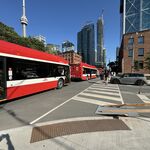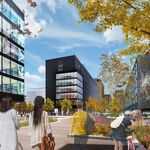CDL.TO
Moderator
Why would it be impossible? Just set forward lights to green when the LRV is approaching.
You can't "just" set green lights. There is a defined amount of time that needs to be dedicated to each stage in the traffic light cycle. For example, if an LRV on Eglinton is approaching Victoria Park and Vic Park has a green signal, it still has to go through the full green, yellow, red cycle and pedestrian countdown before the LRV can get a green light.
This seems to be a good article: http://walkingbostonian.blogspot.ca/2013/02/transit-signal-priority.html
Note that of the four potential techniques, the fourth one, phase rotation, doesn't seem to be considered an option in Toronto (in other words, we won't put the left-turn phase after the straight-through phase). Early green is often not an option because green phases are often already at the minimum required for pedestrians to safely cross the intersection. So you're left with phase insertion, which existed on Queens Quay before the recent construction started, and green extension, which exists on a number of streetcar and bus routes in Toronto today. These do not guarantee a green light.
Transit priority means less waiting at lights, not no waiting at lights.




